





 Back to Top
Back to Top
Since its inception in 1991, this newsletter has been a means of bringing SP teachers closer together, and has provided a medium for exchange of ideas. In its traditional format, how-ever, its impact has necessarily been limited. The advent of our new SPTN Internet address will give teachers the opportunity to have their questions and concerns dealt with immediately and, most importantly, by other teachers in similar situations, anywhere in the world. Successes and failures can be shared while they are fresh in the mind - not restricted by the twice yearly publishing dates.
More and more schools and individuals are getting online. In this issue (p. 5), you will find out how to reach us, and what to expect when you get there, but, as in all networking, the success of the electronic version will depend on you. Get involved - you'll get more back than you give.
 Back to Top
Back to Top
You deal daily with the misconception on the part of students, and perhaps even their parents, that learning science is "hard" and only accessible to the class nerds.
Furthermore, compared to other subjects such as English, algebra, or ancient history, the content of science is far more dynamic, since important discoveries continue to be made in the natural and life sciences. Thus you must be students of science as well as teachers of science.
Finally, science is more a way of viewing the world than it is a body of knowledge. It is therefore not easily learned through lectures or reading textbooks. And, as you all know, it takes a history teacher far less preparation time to dust off last year's notes than it does for each of you to set up a demonstration on the principle of levers.
Nevertheless, you all persist in this occupation, and it certainly isn't for the salary. I hope it's because you recognize that a solid education in science is an essential element for all citizens of the 21st century. And I hope that it is because, every once in a while, you come across a student for whom your science class is simply the most wonderful, mind-expanding experience ever encountered. I was one of these students 30 years ago - one who was sufficiently motivated by my physics class to choose a career in science. When new acquaintances ask me what I do, I am happy to respond that I have the best job in the whole world. I never cease to be amazed that someone will actually pay me to be curious and try to figure out the workings of the Earth around me.
It occurs to me that your success will not be measured by the number of your students that go on to become MIT professors, but rather by your success in opening the minds and broadening the perspectives of the general population.
Our education does not end the day we graduate. Science teaches us that knowledge must be constantly updated, and we must keep our eyes open and our senses sharp.
Henri Poincaré
 Back to Top
Back to Top


Teachers at the Institute were enthusiastic and, as a result, an exploratory pen-pal network has been set up, including SciencePlus classes from 21 states. Chris would welcome pen-pals from the Atlantic Provinces! Teachers who are interested in joining their classrooms to the network can contact Chris Hooker at N. Kirkwood Middle School, Kirkwood, Missouri USA 63122
If any of you do get linked up, we'd love to hear the outcome.
Following the conference, Muriel toured other Australian locations, while Nan & Alan continued on the Papua New Guinea, Singapore, Malaysia, Thailand and Hong Kong; rotten work, but somebody had to do it!
Abu Dhabi, Austria, Bahamas, Bahrain, Bermuda, Brazil, Canada, China, Colombia, Egypt, England, Finland, Guam, Guatemala, Hong Kong, Iran, Ireland, Italy, Japan, Malaysia, Oman, Panama, Peru, Philippines, Puerto Rico, Saudi Arabia, South Korea, Spain, Taiwan, Thailand, U.S. Virgin Islands, U.A.R. U.S.A., Western Samoa.
 Back to Top
Back to Top
The book is called "Language Arts Survival Guide" and you can get more information by writing to:
 Back to Top
Back to Top
If you have access to an "Elmo/TV" apparatus, it can be used effectively to observe the movement of small
organisms such as worms, spiders, insects etc. You can also use it to observe stimulus/response in an
earthworm. (SP1 - Living Things)




"Equipped with his five senses, man explores the universe around him and calls the adventure 'science'". Edwin Powell
 Back to Top
Back to Top
Workshop topics were many and varied: misconceptions students have about science, active learning strategies, graphic organizers, multi-disciplinary teaching etc. Each presentation suggested new approaches, as well as tips on how to incorporate these new concepts in the classroom.
We were shown alternative ways to monitor students progress, how to approach formative evaluation and writing portfolios, the idea of self-directed learning and evaluation, providing the student with more ownership and control of their own education. While these ideas were not new to me, the demonstration of the strategies involved in their implementation was helpful.
This "meeting of the minds" was truly productive, and the camaraderie and friendships that developed has enabled a network to be created where valuable sources of information in planning is available. The opportunity to work with SciencePlus authors was, for me, an added benefit.
In closing, the Science Institute has been valuable to me as an educator, to experience new ideas and to share these experiences with others. Whether singing a chorus of "Sunshine Mountain", solving a murder mystery, or dining on lobster and steak, all participants benefit from a strong and growing network of colleagues and friends. If you wish to start your summer vacation by refreshing your mind while relaxing it, AND have a find time in the process, consider the benefits to your students and to yourself, and join us.
Paul Keliher is project leader of Project Partnerships, a special program for at-risk students at Admiral Westphal Junior High School, Dartmouth, Nova Scotia.
 Back to Top
Back to Top
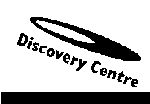
For more details, call the Centre at 492-4422, the Science Hotline at 422-5960 or 1-800-565-7487.
 Back to Top
Back to Top

The Association will provide a list of topics, equipment can be borrowed (through the teacher), and the Association has volunteers in several areas of Nova Scotia who would be willing to act as mentors for students.
 Back to Top
Back to Top
We're not the only ones teaching science to our students! Images of science have been, and are being, portrayed on television, in the movies, and elsewhere. The purpose of this article is to expose two well- known (but inauthentic) images of science.
One of these, the Dr. Jekyll image, is that of the mad scientist working in a dungeon-lab with bubbling retorts, making fiendish scientific discoveries. The image is accompanied by a false description of scientific knowledge, e.g. monsters, secret potions, and werewolves - and experiments that should never have been performed.
Other messages are also carried, beneath the surface, through this "bad" science. For example, the image implicitly conveys that scientists are objective and that science is value-free; otherwise, scientists wouldn't do such things. However, everything we do (and do not do), is based on both personal knowledge and values. So the image of a scientist, who produces monsters from various cut-up body parts, is a poor one to portray to children. It also carries a deeper anti- educational message: that there is knowledge that is best not known. Furthermore, it turns a lot of kids away from science because it shows scientists as antisocial, unprincipled, unlovable nerds. What kid in his or her right mind would identify with that image?
The image plays on our legitimate fear. The fear is legitimate because scientific discovery constantly creates ethical dilemmas that outpace social mechanisms to deal with them, such as whether or not to continue the lives of foetuses with proven genetic abnormalities, to use dangerous new insecticides, or to build nuclear reactors. The fear can be discussed but the image cannot.
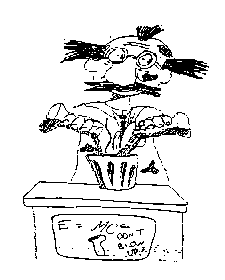 Another inauthentic image is Doctor Schweitzer: the scientist as benefactor of humanity, working
unselfishly for the good of all living things. This image carries an equally false view of science. Called
scientism, it is based on an assumption that science is unquestionably good. Scientific knowledge is
portrayed as more important and valid than other forms of knowledge. We live in a scientistic society. It
can be seen in the success of the "clinically-tested" headache pill commercial. Testing a medication in a
clinic should not be the major basis upon which someone should decide whether to use it.. The scientistic
view of the world is rosy - longer life spans and less disease (in the developed world) - but it often leaves
out the pollution, disenfranchisement, alienation, and death sometimes caused by our use of science.
Another inauthentic image is Doctor Schweitzer: the scientist as benefactor of humanity, working
unselfishly for the good of all living things. This image carries an equally false view of science. Called
scientism, it is based on an assumption that science is unquestionably good. Scientific knowledge is
portrayed as more important and valid than other forms of knowledge. We live in a scientistic society. It
can be seen in the success of the "clinically-tested" headache pill commercial. Testing a medication in a
clinic should not be the major basis upon which someone should decide whether to use it.. The scientistic
view of the world is rosy - longer life spans and less disease (in the developed world) - but it often leaves
out the pollution, disenfranchisement, alienation, and death sometimes caused by our use of science.
Both images portray naive images of what science is. They don't make clear that science is also a community of people working, like everyone else, towards their own ends. Scientists lobby for funding for "their" projects, and try to convince governments, large corporations and foundations that the work they are doing will benefit the organizations that are paying. Scientist are people trying to keep their jobs, progress in their careers, raise their families, and enjoy life, just like you and me.
Science is not being done by quiet bespectacled objective mild-mannered "men" who make the world a better place, nor by megalomaniacal evil geniuses - although there may be examples of both amongst their ranks. Science is being done by groups of people of every different background with all sorts of motives, open and hidden. The images don't explain why scientists, like anyone else, are not always objective and sometimes hold opinions counter to the evidence. They don't demonstrate that science is not truth, but what the community of scientists now believes it to be. Maybe we should be telling kids this when we teach them science.
[John Barnett was a science teacher in Oxford, N.S. for many years, and is presently completing his PhD thesis at York University, Toronto.]
To Order: send name and address, with money order in U.S. funds to:
 Back to Top
Back to Top

The Atlantic Science Curriculum Project has now established a Home Page and an SPTN Mailing List on the Internet. Located on Chebucto Community Net in Halifax, the ASCP World Wide Web page and the SPTN "email" mailing list lets anyone connected to the Internet access this unique resource for science education at the junior high and middle school level. As schools, teachers, students and others interested in science education increasingly come online, the electronic ASCP/SPTN will become a vital part of ASCP's grassroots base.
You can check out the ASCP/SPTN Home Page in two ways. If you have a computer with a modem and an Internet connection, you can Telnet to Chebucto Community Net at chebucto.ns.ca. Once there, register as a guest and go to the Education and Libraries link on the Chebucto Home Page and then to the link for Primary to 12. Scroll or tab down to ASCP/SPTN and you are there.
If you have an Internet access that lets you browse the World Wide Web or WWW (using a browser such as Mosaic or Netscape), here is the URL (Universal Resource Locator) you need to get to the ASCP/SPTN Home Page:
This fall we created the SPTN Mailing List. It is not a newsgroup, but an email distribution system for subscribers of the list. You have to subscribe, but there is no fee! A mailing list puts people with common interests in easy communication. You can post messages to the SPTN list which will go to all subscribers. Your colleagues on the list can respond either to the whole list or directly to you. As membership in the list grows, there will be a lively exchange about teaching science, curriculum ideas, suggestions for revision of SciencePlus, teaching strategies and other related topics. It can be, and already is, both locally oriented to the Atlantic provinces and worldwide in scope. The SPTN Mailing List is all about sharing and participating.
To join the SPTN Mailing List, send an email message to: majordomo@chebucto.ns.ca and in the body of the message (main text area) type: subscribe sptn. You will receive acknowledgment of your subscription a short while later and a welcome message from me.
So check out the ASCP/SPTN Home Page and subscribe to the SPTN Mailing List now. Join the SciencePlus authors and your colleagues in this exciting extension of the Atlantic Science Curriculum Project.
If you have any questions, email me at: pkidd@fox.nstn.ns.ca, by phone (902-443-4262) or c/o ASCPI (1331 Brenton Street, Halifax, N.S., B3K 2K5).
Peter Kidd
[computer.gif]
HOU is a high-school level program that involves Physics, Math and Astronomy. As a junior high school teacher, I was worried that the program might be too complicated for the level of students I teach. After attending the workshop and using the software provided, I discovered there are many ways to integrate HOU into the junior high curriculum. Students will use the computers for much more than word processing or surfing the net.
Image processing software is available on CD ROM for both the Mac and PC environments. Students can zoom in on a blazing halo of the eclipsed sun, search for exploding stars in distant galaxies, and manipulate rich-hued portraits of the planets, doing real scientific problem-solving while learning astronomy, physics, and mathematics. Lessons are carefully prepared and come in a large binder. Mailing lists and Word Wide Web sites are also set up to help teachers and students. This makes an Internet connection necessary, as well as the fact that school may connect with each other and/or the observatory. The plan is for HOU to link together museums and community-based technology centres with schools and universities. There are over 100 schools involved with HOU around the world. Most are in the U. S. but England, Canada, Mexico and Sweden are involved as well.
...Mike McCormick is a teacher at Rockingham School
[Editors Note: Are you involved in or planning a project linking computers, science, and technology? We'd love to hear about it!]

1. MECC "Oh Deer!" - Students manipulate the number of animals in a deer herd by using strategies recommended by the area's Department of Natural Resources.
2. MECC "Odell Lake" - In this simulation, students can create their own food chains and webs.
3. "5 Kingdoms" - This interactive tutorial deals with the five kingdoms of living things and discusses why life forms are sorted into groups.
4. "Thirty Elements" - This tutorial disc teaches the spellings and atomic symbols for the first 30 elements of the Periodic Table.
Linda also uses Appleworks Database to have her students organize a personal dictionary of significant scientific words in SciencePlus.
If you would like more information on any of the above, you can contact Linda at:
 Back to Top
Back to Top
In my classroom, I have a "Problem of the Week" board which includes a question related to the curriculum, the science world, or just general knowledge & thought questions. ("MindTrap"* is an excellent resource for this.) Students may also submit questions to me that they would like to have posted. Each student is allowed to submit one answer entry per week in the Problem of the Week box. Each Friday, last class, a name is chosen from those who have given the correct response, and a small prize is awarded to the winner. Every Monday, a new question is posted and the answer to last week's is also given. Any student in the school is allowed to participate, and students really have fun with this.
* MindTrap is published by MindTrap Games Incorporated, Oakville, Ontario, L6M 2S0 and is available in both French and English, at good toy stores, priced around $30.
You will need: large tarpaulin, masking tape, stopwatch, and students' earthworms.
On the tarp, mark two concentric circles, 60 cm and 180 cm diameter respectively. Assign two "timers" to record official times.
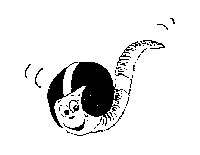
Earthworms have 3 minutes to clear inner circle or they are disqualified. Those which qualify must exit
the larger circle in a 10-minute time. The winners in each class continue to race until a final winner is
declared. Worms cannot be touched during the race but may be encouraged with water sprays, etc.
Shirley and Isabel give certificates for participation. A trophy, topped with a rubber work from a fishing supplies outlet, goes to the overall winner. As the races are run, they announce the day's results for the PA: "Fred, owned by Marie Barnes, went segment to segment with Joe Bert's worm, Billy Bob; after completing a full circle, Billy Bob found his bearings and won the race in 4:04, today's record time. Joan Power's worm collapsed on the track and died of hearts failure, all five hearts apparently failed..." You get the idea!
Shirley recommends three resources for the study of earthworms:
1. McLaughlin, Molly. Earthworms, Dirt and Rotten Leaves Avon Books, Dept. FP, Madison Ave., New York, NY Tel: 1-212-481-5653 Cost: $ 2.10
2. Bosak, Susan. Science Is Scholastic Canada Ltd. Cost is $29.95 but you can get a $10 reduction by ordering from The Communication Project, 164 Tomlison Circle, Markham, Ontario, L3R 9K2 or by calling 1-800-772-7765, and tell them you are a teacher of SciencePlus!
3. Video: Darwin's Plow, available from Media Services.
 Back to Top
Back to Top

A variety of needs can be met through portfolios. Usually, the purpose is decided by the teacher. Portfolios can be used to indicate understanding of particular concepts or skills. As well, they can provide an overview of student progress in a particular subject, show parents what is being done in school, provide an opportunity for student self-reflection, and provide evidence for evaluation. Sometimes, they are used to help the teacher of the next grade in planning for the needs of individual students. Whatever the purpose, it should be thoughtfully chosen and clearly communicated to the students.
Once the purpose of the portfolio has been identified, a decision must be made as to the kind of evidence to be collected. Some teachers prefer to do this in collaboration with their students. The teacher may also wish to specify certain evidence that must be included, as well as allowing students to add items of their own choosing. Whatever is done, it is crucial that students be asked to explain how the evidence in the portfolio is related to the purpose of the portfolio. This might be done by having a caption for each submission which states what the evidence is and why it is considered to be evidence. Understanding the relationship between the evidence and the purpose helps students reflect on what they have learned.
The following list may be helpful when deciding what will count as evidence:
Portfolios offer opportunities for students to make decisions and to reflect on their own learning. If you have decided to implement portfolios in your classroom, please let us know. We would like to hear about your experiences.
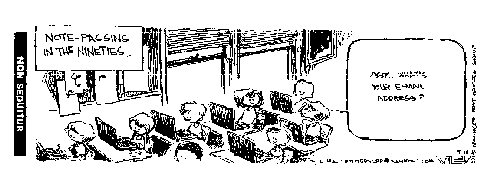
 Back to Top
Back to Top
Although I didn't realize it then, questions and finding the possible answers would become the norm in my class. I don't pretend to know everything about science. I read a lot of magazines and literature but that never seems to answer all the questions. My students also do a lot of their own reading and researching, trying to answer the questions they bring to class. But, as a new teacher, I would have to say that my most valuable and precious resource, in helping me to find my way and helping me to keep my feet firmly planted on the ground in the SciencePlus program, has been my colleagues. No university program can give as much support, wisdom, guidance and helpful hints as those who are in the same situation. Some day I hope to be able to give back at least some of the help that they've given me.
Science is all about discovery and asking questions, and boy, have I done a lot of that these past two months! More than I ever thought possible. I know I will continue asking questions: to my students, to myself, and to my colleagues, for the rest of my teaching career. Isn't that what being a science teacher is all about?
 Back to Top
Back to Top
Using the materials provided, students will construct an object that, when held under water and released, remains stationary. Students will need at least 20 minutes to come up with a successful "Flinker".
Pierette makes the following suggestions: try your local deli for large pickle jars; store the materials in plastic storage bags, which can be kept in the jar; have on hand 2 wire cutters (since some groups will wish to alter the length of the paper clips) and enough scissors for those who want to trim styrofoam or foil.
This would fit well with the "Floating and Sinking" unit, but could provide an interesting problem-solving activity for any level, at any time. Good event for Science Olympics too!
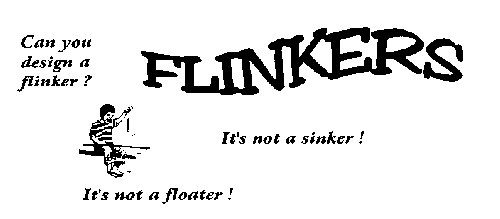
 Back to Top
Back to Top

 Correspondence to:
Correspondence to: